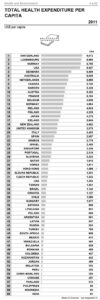
How important is healthcare to preserve competitiveness?
Moreover, what has been the impact of the financial crisis on the attention that governments have given to medical care to the population?
Since 2008, the average economy analyzed in the IMD World Competitiveness Yearbook has increased its total health expenditure per capita by 30%. This compares to an average GDP growth (not annualized) of 13.5% between 2008 and 2012. Generally speaking, in a period of crisis governments seem to prioritize healthcare. Of course the data hide significant differences among countries. Emerging economies such as China, Brazil, and Russia, all have seen increases in expenditure by more than 50%. In contrast, most European countries (and significantly among them, the U.K., France, and all peripheral countries in the Euroland) have witnessed mild, if not negative, changes in health expenditure. These are all countries where the starting levels of public expenditure are significantly higher. In the average economy, total healthcare expenditure was about $2,000 per capita in 2008; in Europe it was $3,000.
Where do we stand as we begin 2014? Our latest rankings show that countries that spend the most in healthcare are Switzerland ($9,072 per capita), Luxembourg ($8,900), Norway ($8,795), and the USA ($8,627). It does not necessarily follow that it is in these countries where healthcare is the best. Belgium ranks number one in the question “Health infrastructure meets the needs of society,” but it is only 12th in public healthcare expenditure. And while the USA is the fourth country by healthcare expenditure, it ranks 30th in health infrastructure.
The countries that spend the least in healthcare are: China Mainland, Ukraine, Thailand, Philippines, Indonesia, and India. What the data show are dramatic differences among countries. The highest spending economy in our rankings (Switzerland) spends 150 times more in healthcare than the lowest-ranked country (India). Italy (ranked 20th) spends almost four times as much as Poland (40th). Countries that spend the least in absolute terms also spend little relative to GDP. So it is not just that they are poor—they do not prioritize healthcare.
Our conclusion is that differences in health policies are creating a significant gap in competitiveness between rich and poor economies.

Research Information & Knowledge Hub for additional information on IMD publications

New models of economic development are emerging from global trade fragmentation. Supply chain executives must now weigh far more complex trade-offs, says Christos Cabolis

When the world’s cities compete for talent, innovation, and investment, intelligence—not size—determines who wins. The Smart City Playbook is a fascinating journey into the front lines of urban transformation, written by Arturo Bris, one of the wo...
In a world fractured by rival empires and the rise of protectionist ideologies, Europe remains an exception: a continent of stability, rules and trust. Too often described as a museum of past glories, it has in fact become the most prosperous, equ...

How do national strategies interact with industry dynamics? Four different paths to digital competitiveness.

Global trade is re-wiring without the US leading to the rise of new trade coalitions according to trade experts from IMD and the Hinrich Foundation.
In World Competitiveness: Rewriting the Rules of Global Prosperity, Stephane Garelli, a world-renowned professor who has pioneered this concept, explains what World Competitiveness means and implies, and why it has become such a strategic priority...

Efficiency once defined competitiveness but resilience and trust now lead. David Bach shows why Europe’s leaders need optimism to unlock both.
Moving the cogs in a country’s productivity system requires the right kind of talent. Let’s consider them the oil. The usefulness of this oil depends on all manner of inputs, such as the quality of the education system and the attractiveness of th...

This book is a vindication of Europe. It challenges the view of Europe as a tired, overregulated continent, arguing instead that Europe has emerged from decades of crisis—financial turmoil, Brexit, COVID-19, war in Ukraine—as a resilient, reformed...
When policymakers start using internet slang to describe the economy, it is a sign something is not right. The word neijuan was once used by Chinese students to depict burnout from seemingly pointless competition. Now it is showing up in policy la...
Research Information & Knowledge Hub for additional information on IMD publications
Research Information & Knowledge Hub for additional information on IMD publications
Research Information & Knowledge Hub for additional information on IMD publications
in I by IMD
Research Information & Knowledge Hub for additional information on IMD publications
Research Information & Knowledge Hub for additional information on IMD publications
Research Information & Knowledge Hub for additional information on IMD publications
Research Information & Knowledge Hub for additional information on IMD publications
IMD World Competitiveness Center Report, September 2025
Research Information & Knowledge Hub for additional information on IMD publications
Research Information & Knowledge Hub for additional information on IMD publications
Research Information & Knowledge Hub for additional information on IMD publications

